Year-End Fundraising Anxiety Got You Down?
Do you have that year-end feeling?
You know, the one that many fundraisers get around this time of year?
Kind of frenetic? Kind of anxious?
You’re not alone.
Do you have that year-end feeling?
You know, the one that many fundraisers get around this time of year?
Kind of frenetic? Kind of anxious?
You’re not alone.
Here come 14 steps to successful email fundraising.
You’re no doubt planning your year-end fundraising strategy now. How big a role is email going to play?
If you’re making your email campaign an afterthought, don’t. That holds for this year, and the foreseeable future. It holds before, during and after your pitch.
If you get good at email marketing and fundraising, you won’t be wasting your efforts.
Not today. Not tomorrow.
Since the end of the year is when most of the money is raised, there’s no time like the present to begin.

What can you do now to prime the pump so your donors are pre-disposed to give to you when they receive your next appeal?
In Part 1 of this two-part series I described research from Robert Cialdini, author of the seminal Influence: The Psychology of Persuasion, and his newer book, Pre-Suasion: A Revolutionary Way to Influence and Persuade, and discussed how you might apply this research to your fundraising strategies. We learned the importance of leading with a “gift” or “favor” that would incline your donor favorably in your direction.
Today we’ll look at how to cement the likelihood your favor is returned, as well as explore some types of favors that are likely to be perceived as valuable.
Annual giving is the cornerstone to any nonprofit fundraising effort.
And while some organizations think of annual giving as a way to raise money for their operational expenses and other projects and causes, I’m about to let you in on a secret:
It’s not.
A very accomplished friend of mine recently wrote a beautiful and provocative article I want to share. It resonated with me on many levels, not the least of which spoke to me wearing my hat as a philanthropy facilitator and nonprofit coach.
Thank you Tara Mohr for having the courage to share On Political Fear. Tara writes:
I don’t do othering. I don’t think one party or place on the political spectrum has a monopoly on truth. I think we all need to be speaking up right now.
Tara, in speaking up, describes herself as “proudly afraid.”
Thinking about how to get more new donors this year? Wondering if you should purchase lists?
Consider this: Response to peer-to-peer fundraising is about 25% compared with direct-to-donor campaigns where response is 1 – 2%.
Why? People respond better to people than they do to organizations. Especially when it’s people they know and trust.
Never think of your event as a stand-alone. That’s a waste of your time.
Always think in terms of “What’s next?”
You must always be cognizant of moving folks along a relationship continuum.
From awareness… to interest… to involvement… to investment.
I recently learned about Van Jones’ virtual reality experiment, Day of Empathy via this video (thank you, thank you, thank you to Nancy Schwartz for writing about this on her Getting Attention nonprofit marketing blog: OMG Experiment to Connect & Activate (Dream Corps Case Study). The idea is to use virtual reality to build empathy (i.e., to help people walk in the shoes of others) in order to motivate action.
The idea of using virtual reality to build empathy on a communal scale is brilliant!
And it ties back to Darwin’s theory of survival.
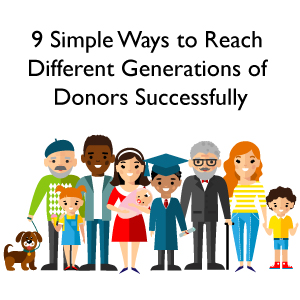 We’re in the midst of a generational shift: Millennials have recently surpassed Boomers as the largest generation in America, and have surpassed Generation X as the largest part of the American workforce.
We’re in the midst of a generational shift: Millennials have recently surpassed Boomers as the largest generation in America, and have surpassed Generation X as the largest part of the American workforce.
As these changes happen, nonprofits should take a look at their marketing channels and make sure they are using the right methods to reach each generation.
 What prompted me to write this article was a recent post by Matthew Sherrington on the 101 Fundraising Blog about the dangers to the public benefit sector posed by erosion of trust. We’ve known for some time that whenever there’s a charity scandal, the bad behavior of one player can become detrimental to all. But over the past year in the U.K. the problem has become even more challenging. Could it happen here? Matthew says “yes.” And I concur. Trust is a fragile thing.
What prompted me to write this article was a recent post by Matthew Sherrington on the 101 Fundraising Blog about the dangers to the public benefit sector posed by erosion of trust. We’ve known for some time that whenever there’s a charity scandal, the bad behavior of one player can become detrimental to all. But over the past year in the U.K. the problem has become even more challenging. Could it happen here? Matthew says “yes.” And I concur. Trust is a fragile thing.
In the U.K what happened was a perfect storm of perceived over-solicitation and insufficient outcomes, exacerbated by a barrage of media that sounded an alarm about nefarious practices. Trust plummeted. A wake-up call, for sure.
But what does it mean?
This is important.
It’s about a new report that may change how you do fundraising.
It should.
Let me explain.
By tending to focus more on expensive, staff-intensive acquisition strategies like direct mail and special events, charities are bringing in one-time donors who never give to them again.
The majority of nonprofits are not paying enough attention to social media. This may have been understandable five years ago. Today, it’s just plain dumb. If You’re Absent No one Can See You Nonprofits constantly talk about their need to “build awareness.” In our digital world, it should be patently obvious that if you want…
Imagine you’re baking a cake. You put in the flour, eggs, milk, and sugar, whip it all together, and put it in the oven for an hour. But, when the timer dings and you open the oven door, you find that instead of one perfect cake, you have two!
This situation is physically impossible (unless you’re a wizard or a magician), but it’s a good illustration for how matching gift programs can benefit your nonprofit.
When donors take advantage of their employers’ matching gift programs, they essentially double the amount of money that they give to your organization. Two cakes (I mean, donations!) for the price of one!
Hope you enjoy these links, free resources and training opportunities. Again, I’ve organized according to two of the top 5 areas I’m hoping you’re working on improving this year. This week it’s:
There are also some “food for thought” articles in other areas, plus links to free resources and upcoming training opportunities. There’s bound to be something here you’ll find useful!
Hope you enjoy these links, free resources and training opportunities. Again, I’ve organized according to three of the top 5 areas I’m hoping you’re working on improving this year. This week it’s
There are also “food for thought” articles in other areas, plus links to free resources and awesome upcoming training opportunities. Use ’em or lose ’em!
Philanthropy is a mindset. An embracing culture. A noble value.
Fundraising is a means towards that end. Servant to philanthropy.
Philanthropy, not fundraising.
This has been the tagline for my business and blog since I began Clairification in 2011. It grew naturally out of my experiences working as a frontline development director for 30 years. I’ve always insisted that no single person could possibly receive credit for a donation. “Donors don’t give because of development staff,” I’d tell program staff. “They give because of the great work you do!”
 In Part 1 of this article I encouraged you to make this the year you begin to study psychology and apply it more to your integrated development (marketing and fundraising) strategy. I shared with you an infographic developed by marketing strategist Gregory Ciotti that some of the psychology underlying human behavior. Because there’s a lot for nonprofits to learn and apply, I’m taking you through them one by one. Today let’s complete the Top 10 list.
In Part 1 of this article I encouraged you to make this the year you begin to study psychology and apply it more to your integrated development (marketing and fundraising) strategy. I shared with you an infographic developed by marketing strategist Gregory Ciotti that some of the psychology underlying human behavior. Because there’s a lot for nonprofits to learn and apply, I’m taking you through them one by one. Today let’s complete the Top 10 list.
 Today’s focus is on donor retention, as our year-long “Dive the Five” virtual course continues! In fact, you can use the principles you learn here for donor acquisition as well. In for-profit parlance, we’ll be discussing how to “convert customers.” In non-profit parlance it’s all about turning prospects into donors and donors into repeat donors.
Today’s focus is on donor retention, as our year-long “Dive the Five” virtual course continues! In fact, you can use the principles you learn here for donor acquisition as well. In for-profit parlance, we’ll be discussing how to “convert customers.” In non-profit parlance it’s all about turning prospects into donors and donors into repeat donors.
I encourage you to make this the year you begin to study psychology and apply it more to your integrated development (marketing and fundraising) strategy.
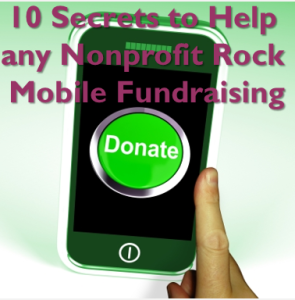 “Human beings have always been social animals. The digital revolution has simply made electronic media (email, the internet and social media) our ‘go-to’ place to socialize and connect with our fellow humans.”
“Human beings have always been social animals. The digital revolution has simply made electronic media (email, the internet and social media) our ‘go-to’ place to socialize and connect with our fellow humans.”
This sentiment that Claire crafted really spoke to me as I was reading her article the other day.
It’s a deep truth. We are social beings. We’re also incredibly mobile now, though.
Ironically, even though we’re constantly on the go, we are the most connected we’ve ever been.
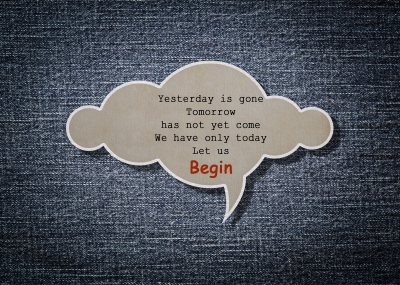 Two good posts recently at re: charity (Brady Josephson) and Future Fundraising Now (Jeff Brooks) about what charities should do today to prepare for tomorrow. Both embrace a quote from Jeff Bezos:
Two good posts recently at re: charity (Brady Josephson) and Future Fundraising Now (Jeff Brooks) about what charities should do today to prepare for tomorrow. Both embrace a quote from Jeff Bezos:
I very frequently get the question: ‘What’s going to change in the next 10 years?’ I almost never get the question: ‘What’s not going to change in the next 10 years?’ And I submit to you that that second question is actually the more important of the two — because you can build a business strategy around the things that are stable in time.
Sounds good.
But think about this a bit more.
 Two good posts recently at re: charity (Brady Josephson) and Future Fundraising Now (Jeff Brooks) about what charities should do today to prepare for tomorrow. Both embrace a quote from Jeff Bezos:
Two good posts recently at re: charity (Brady Josephson) and Future Fundraising Now (Jeff Brooks) about what charities should do today to prepare for tomorrow. Both embrace a quote from Jeff Bezos:
I very frequently get the question: ‘What’s going to change in the next 10 years?’ I almost never get the question: ‘What’s not going to change in the next 10 years?’ And I submit to you that that second question is actually the more important of the two — because you can build a business strategy around the things that are stable in time.
Sounds good.
But think about this a bit more.
“My board is driving me nuts!”
Today is “leap day” — that little something extra we’re given every four years, just to slow things down a bit and make February last a bit longer.
Leap day has something in common with nonprofit boards of directors — that little something extra, volunteers put in charge of the business, that has an unfortunate tendency to slow things down and make decision-making take a lot, lot longer than it usually should.
Do you want to increase your fundraising proceeds dramatically, without significantly increasing your resources?
In this post, you’ll learn how to effectively increase your fundraising proceeds through use of online Peer-to-Peer fundraising.
Peer-to-Peer fundraising (P2P fundraising) is the idea of leveraging your cause/organization’s supporters and empowering them to become your best fundraising advocates in order to expand your mission’s reach and grow your donor base and proceeds. It’s a multi-tiered approach, where donors are asked to raise money in addition to donating.
This year I’ll be sharing a lot of resources related to the “Dive the Five” fundamental principles we’ll be discussing in our ongoing virtual fundraising curriculum. You remember them, don’t you?
I want you to use these “buckets” as an organizing framework for your development efforts this year, so I’m organizing my “Click-its” this way as well.
From time to time I’ll add in other subjects and offer you some food for thought that I just can’t help but share with you. And, as always, if you scroll to the bottom you’ll find some free resources and upcoming learning opportunities.
This week’s Click-it is another mélange of fundraising wisdom, ranging from events to social media and taking a look at which generations are good target markets for you. Plus some fun posts.
And, as always, if you scroll to the bottom you’ll find some free resources I’ve selected for you. There’s some really worthwhile stuff here — and I’ve got a lot of it this week.
See you next week where I’ll return to my “Dive the Five” virtual nonprofit curriculum. Want to know the top five priority areas for your focus in the coming year? Make sure you’re subscribed to Clairification so you don’t miss an article!
And now, on to this week’s articles…
This week’s Click-it is a mélange of fundraising wisdom, beginning with mission statements, target markets, email tactics, fundraising psychology and some insight from the invariably provocative Seth Godin.
And, as always, if you scroll to the bottom you’ll find some free resources I’ve found just for you.
You may recall that I promised to do new something new this year – “Dive the Five.”
I’ve selected five major themes to discuss with you this year in depth.
This week’s Click-it is all about major gift fundraising. What better way to begin the new year than by thinking BIG?!
I’ve pulled together an awesome group of posts from some of my favorite major gift fundraising experts.
There’s also an opportunity (at the end) for you to delve deeper into major gifts fundraising this year.
I wish you BIG, considerably sizeable fundraising results this year in order to accomplish your BIG, considerably important and serious mission.
This week’s Click-it is more of a holiday season “Open-it” collection of gifts. For the second year in a row, I’ve gone shopping and will offer you one or more free gifts every week from now until the end of the year.
These are all good. And the first one today is a real doozy — a gift to me that I’m “re-gifting!”
It’s here, it’s here!
That giving time of year!
My dear, don’t fear!
It’s time to get in gear!
Good cheer, get clear,
As the year-end draws near…
Bad poetry aside, it really is the time to get all your ducks in a row so you don’t miss out on this time of year when many charities will receive as much as 40% of their entire annual campaign goal.
So I’ve got 13 tips to give your year-end fundraising a shot in the arm!
In my previous Year-End Fundraising Planning Editions One and Two I promised I would have more for you as year-end – and the biggest fundraising time of the year for most nonprofits – inexorably approaches. Salsa reports that end-of-year giving can result in 40% or more of total yearly donations.
Online giving gets particularly frenetic at this time of year.
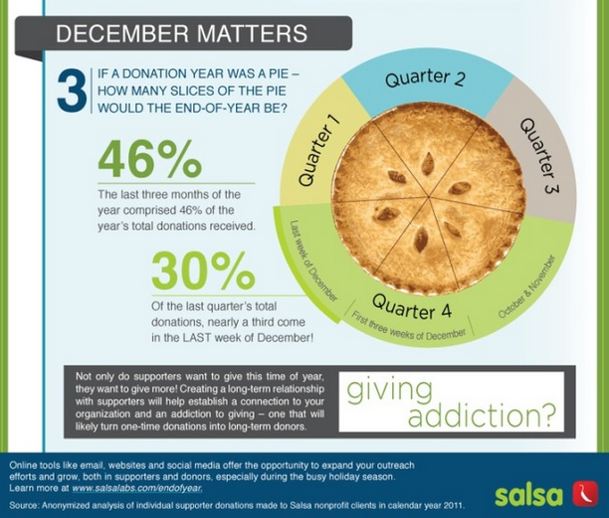
Still stuck for subject lines for your year-end emails?
Your subject line is like your outer envelope for direct mail.
A window into your message.
Make sure it’s open enough to give a glimpse of something intriguing… urgent… exciting… emotional… shocking… funny… useful… anything compelling to grabs folks’ attention.
The more specific and to the point, the better.
NOTE: if you’re not planning a series of year-end emails — get on it NOW! If you’re sending less than 7 emails in December, you’re below the nonprofit average. You don’t want to be below average do you?
As much as a full third (33%) of December gifts occur on the 31st of the month! Last year the percentage increase in overall fundraising was 2.1%, while the increase in online fundraising was 8.9%.
If you’re not online, putting forward your most compelling fundraising offer at a time when folks are primed to give the most, you’re missing your best opportunity.
Here are some subject line techniques I particularly like, with thoughts about how you can use them to boost your year-end fundraising:
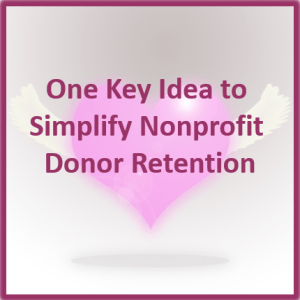 Want to keep more donors? It’s simple really.
Want to keep more donors? It’s simple really.
What it all boils down to is one key idea. YOU.
You and the role you play in assuring your donor gets lasting satisfaction from their gift.
A prompt, personal thank you is a beginning. Yet it won’t have lasting effect.
You must go above and beyond the “donor receipt” —
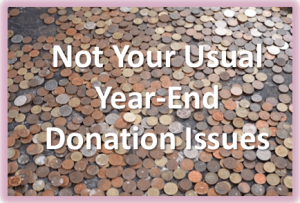 I doubt you’re worrying your pretty little heads about this stuff, but you should be.
I doubt you’re worrying your pretty little heads about this stuff, but you should be.
Because year-end giving is simply too fraught with angst — and it needn’t be that way!
Not an anxious period of wondering whether their credit card transaction is secure, whether their gift went into a black hole or whether you’ll use it as they intended.
And guess what else?
Not an unmitigated nightmare of receiving credit card numbers that don’t work, worrying about how already busy staff can possibly process all your year-end donations and, for that matter, do so in a timely, professional and personal manner.
So give yourself and your donors a break.
How to do this?
 This week’s Click-it is an eclectic mix of goodies. Maybe not as good as Thanksgiving turkey, stuffing, sweet potatoes or pumpkin pie, but sometimes your mind and soul need feeding too!
This week’s Click-it is an eclectic mix of goodies. Maybe not as good as Thanksgiving turkey, stuffing, sweet potatoes or pumpkin pie, but sometimes your mind and soul need feeding too!
To my friends in the U.S. who celebrate Thanksgiving this week, have a good one filled with many blessings. For those of you scattered elsewhere around the globe, make yourself a nice meal anyway and gather together with people you love. Life’s too short not to.
This poem I wrote several years ago seems particularly appropriate this year, so check out “Attitude of Gratitude” if you’ve a mind to.
And if you can, try to find some time this week to dig into some of these resources.
Now… go make our world a more caring place, and hug yourself some hope!
I am thankful for you,
This week’s Click-it is dedicated to your year-end success!
December is the biggest fundraising opportunity of the year. What you do between now and December 31st will impact what you’re able to accomplish through the rest of the year.
It’s now or never.
Please. Seize your opportunity!
But do it right.
It’s no longer just about direct mail or an email or two.
You’ve got to think about your website, thank you pages, social media and peer-to-peer fundraising – just to name a few. Old school is good, and there are some tips in the articles that follow to help you. But they’re no longer enough.
You must use online techniques to leverage offline techniques.
Think of social media and your website home page as advertising for your appeal. So that when folks finally receive your request for a gift, they do so with eyes and ears wide-open. Because they’ve been primed.
Ready? Let’s get started!
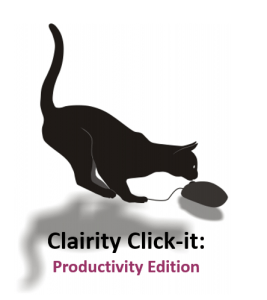
This week’s Click-it is dedicated to productivity. Yours.
Sometimes I like to find useful information that has nothing to do with nonprofit work, per se, but which has to do with being a human being working to be efficient and effective in our fast-paced world — all while balancing work and personal life. So I’ve collected a bunch of resources to help you work smarter, faster and better while also becoming less stressed, more relaxed, more focused and much more happy. Sounds like a good deal, right?
I know you think you have to run yourself into the ground to take care of the folks who rely on you for help. There’s so much to do and it’s all so important!
But to take care of the world you must take care of yourself first.
Why not send this entire post to everyone on your team; then ask them to come back to your next staff meeting with ONE thing they’re going to do differently as an individual and one OTHER thing they’d like to suggest doing differently as a team?
It could be fun – and a nice break from business as usual.
Ready? Let’s get started!
 Not long ago I went to research something online and ended up viewing the first entry Google gave me – which was on Wikipedia. To my delight, I ran into an awesome fundraising campaign (this is an occupational hazard with fundraisers – we actually like and admire things like pledge breaks when they’re done well)!
Not long ago I went to research something online and ended up viewing the first entry Google gave me – which was on Wikipedia. To my delight, I ran into an awesome fundraising campaign (this is an occupational hazard with fundraisers – we actually like and admire things like pledge breaks when they’re done well)!
Here’s what I found superimposed at the top of the screen:
This week’s Click-it is dedicated to helping you increase your fundraising revenue through a number of different strategies: monthly giving, sponsorships, targeted campaigns (e.g., #GivingTuesday), targeted communications, cause marketing, crowdfunding, cultivating mid-level donors, and more. These strategies will both help elevate awareness for your cause and increase your base of supporters.
And towards the end of the “Click-it,” as usual, you’ll find a bunch of completely free resources!
 I’ve been thinking a lot about crowdfunding lately.
I’ve been thinking a lot about crowdfunding lately.
Bzz… bzz… buzz… buzz… Do you hear it?
It’s the sound of the times. It’s the bees flying around crowdfunding campaigns like honey. Sweet, golden honey.
Are you getting yours?
With the mainstream shift into digital communication, and the advance of technology through online donation and peer-to-peer fundraising platforms, crowdfunding is something I believe you should seriously consider if you’re not already getting your “crowd” on.
Especially if you have…
So I’ve put together a few resources, and some of my own thoughts, to help you think things through.
This week’s Click-it is dedicated to the best ways to communicate your message as well as best ways to measure your success.
All of this is super important as we approach the year-end fundraising season.
If you’re not the person who might benefit most from some of these articles, please pass them along to those who might find them useful. Be good to your team!
It’s October! We’re entering prime fundraising season, and there’s no better time to sharpen your major gift skills. So this week’s edition is dedicated to exactly that. From prospect identification to cultivation to asking to follow-up. At the bottom you’ll find some new free resources, a chance to participate in a crowd-sourced major gifts blog and a last chance to actively prepare for your major gifts solicitations with some dynamic webinars and a practice clinic. Ready?
The end of the year continues to approach, and prime fundraising season is upon us! So today we have a couple of articles to remind you what your real job is as you prepare your year-end campaigns and strategies. Plus, some tips to help you amplify your fundraising team. And a bunch of social media tools, exercises and good advice; in 2015 social media should be an integral part of your end-of-year work plan. At the bottom you’ll find some new free resources and a last chance to prepare for your major gifts solicitations. Ready?
The Click-it is early this week since year-end is fast approaching, and I couldn’t wait to share these awesome tips to help you plan your year-end campaign! I’ve got a bit of everything here – from finding email addresses to build your online mailing list… to tips on getting appeals read… to making sure you’re not missing any tricks… to social sharing strategies… to best email subject lines… to Giving Tuesday — and more! I’ll no doubt have even more for you before the end of the year, but now is really the time to get started. Don’t delay. [If you really want to assure you don’t miss a trick, scroll down to the bottom and check out the webinar I’m offering with the Foundation Center on the 17th]
On the anniversary of 9-11, I’ve put together a group of posts that show that more people than not want to do good in this world. There’s a lot of inspiring food for thought here. Plus, since the critical end-of-year fundraising window is fast approaching, I’ve got a few things to help you with your planning – not only to acquire donors, but to sustain their giving over time. Plus one thing I thought was pretty cool, and that just brought a smile to my face! Spend a few minutes today to reflect on how we can come together to heal the world.
As the end of the year approaches, are you planning enough emails?
Emails should be included as part of your robust, multi-channel annual appeal if you want to increase your chances of reaching your goals. On top of that, emails can be a great way to set yourself up for success even before you send an appeal.
Sadly, many nonprofits I encounter are unwilling to email their constituents sufficiently. Here’s what I often hear:
We don’t want to tick them off by mailing too many times.
We can’t ask them for money more than once or twice a year.
They get a lot of mail from us and it’s probably annoying.
They’re probably getting mail from a lot of different departments, so we don’t want to send from our department too often.
This week I’ve another potpourri of links on a variety of fundraising, nonprofit management and nonprofit marketing topics. Some practical stuff, some food for thought, some free resources and a last chance opportunity to improve your year-end fundraising (scroll to the bottom). I hope you’re enjoying the last days of the season!
Fundraising Pride
This week I’ve a potpourri of links on a variety of fundraising, nonprofit management and nonprofit marketing topics. It’s still summer, so I figure it’s a good time for a varied reading list. Some practical stuff, and a little food for thought. Why not?
List Building
Click-It: How to Build Your Email List from LinkedIn and Twitter. This post by Amy Hall on the Maximize Social Business blog offers some great practical tips for converting your social media contacts into supporters. After all, isn’t that one of the major reasons you’re trying to generate more connections and followers?
Calls to Action
Click-It: 12 Nonprofit Call-to-Action Twitter Images to Study and Learn From. This is a great collection of examples from Nonprofit Tech for Good.
The 2015 Millennial Impact Report was released last week, and lots of folks are weighing in on what this means for nonprofits. Why is everyone all agog? These folks, born between 1980 and 2000, represent huge buying (aka donating) power and influence. As the lead researcher and president of Achieve, a lead researcher in the study, notes:
“The Millennial generation is influential. From their buying power to their handle on the limitless potential of social media, Millennials can address issues and be a voice for a cause like no other generation before them.”
I was particularly interested in how they gave:
In other words, they’re just as multi-channel as the Boomers and Gen X, with a skewing toward more online activity. There’s plenty of food for thought in the articles that follow, with some great suggestions for how you might consider reworking your fundraising and marketing strategies to engage greater numbers of this emerging generation.
BTW: I’ve thrown in a couple of articles that apply to all generations. The plain and simple fact is that marketing is changing for everyone.
This week is all about your donors: keeping them; communicating with them, taking care of them and meeting them where they are. I’ve got several really useful articles for you. Not too many. It’s summer, after all! Plus, as always, some terrific upcoming learning opportunities for you.
Donor Retention
Fundraisers report that money is the number one reason they leave their jobs [See Part I of this two-part series here]. While I do believe too many fundraisers are underpaid relative to their skill sets and performance, I’ve a hunch it’s not the real chief culprit for fundraiser dissatisfaction. What is?
Guess what? The reason is very similar to why donors leave you. If you read through this article, you’ll learn both (1) how to keep more fundraisers, and (2) how to satisfy, inspire and retain more donors.
Ready?
I gave you a hint in the title. Yup. It’s what Aretha Franklin famously sang about:
It’s not just respect for fundraisers as individuals that’s lacking. It’s respect for their profession. For what it takes to succeed with development in a nonprofit organization. For what it means to be a part of a team — all working together towards the same goal — and why it’s impossible to succeed without a supportive infrastructure and culture.
And by the way, donors won’t thrive absent a supportive culture and infrastructure either. They’re looking to be a part of your community, your family, your way of life. If you won’t give them this warm, fuzzy, connected feeling — they’ll find someone else who will.
So what pre-conditions must be in place for fundraising staff, and donors, to want to stay?